#Kings Landing Historical Settlement
Text

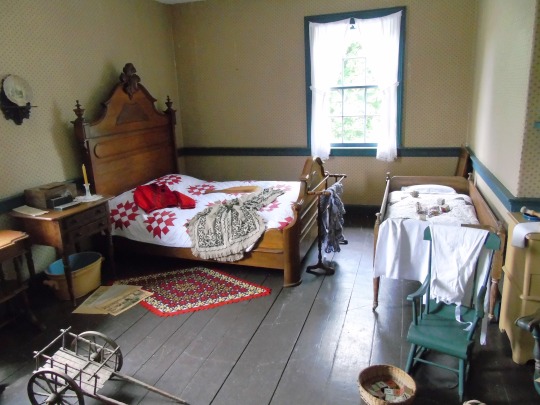


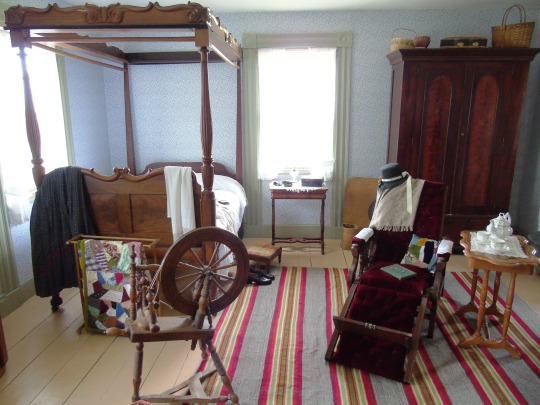

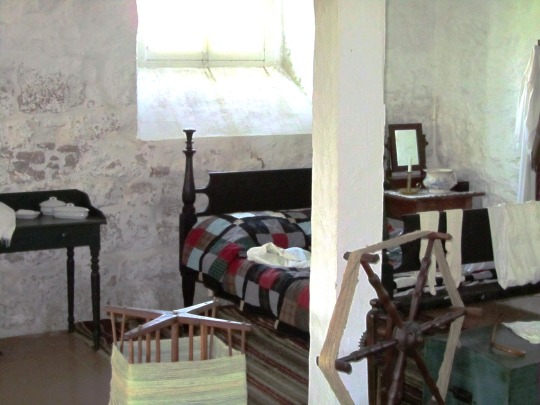
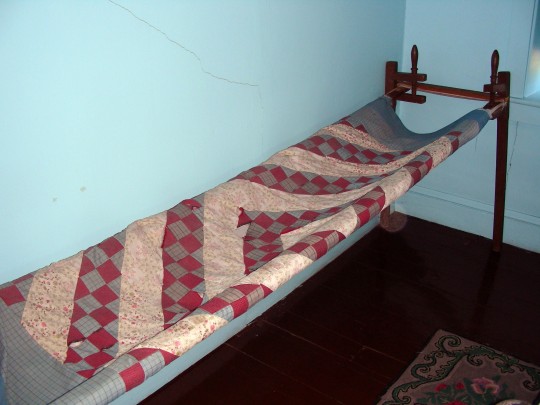




National Quilting Day
A quilt is a type of bed cover, traditionally composed of three layers of fiber, a woven cloth top, a layer of batting or wadding, and a woven back, combined using the technique of quilting. A quilt is distinguishable from other types of blankets because it is pieced together with several pieces of cloth.
National Quilting Day recognizes quiltmakers and their quilt-making abilities. The word ‘quilt’ comes from the Latin word ‘culcita,’ which means stuffed sack, it became adapted to the English language from the French word ‘cuilte.’
Quilting practices can be found in almost every area of the world and it is celebrated on the third Saturday in March every year. The National Quilting Association started National Quilting Day in 1991 and since then it has grown into a global celebration for all quilt lovers and makers.
History of National Quilting Day
Quilting refers to the technique of joining at least two fabric layers by stitches or ties. The quilting practice dates back as far as 3400 B.C. It was mainly a practical technique that provided physical protection and insulation. However, decorative elements were often also present and many quilts are now primarily art pieces.
In the United States, quiltmaking was common in the late 17th century and early years of the 18th century. In these times, only the wealthy had the time to practice quilting so it was done by only a few persons. Commercial blankets or woven coverlets were a more economical bed covering for most people unlike the colonial quilt bed covering which displayed the fine needlework of the maker, such as the Baltimore album quilts. Presently, quilting is now a popular hobby, with an estimated base of twenty-one million quilters.
The oldest example of a quilted piece is kept at the Saint Petersburg department of the Russian Academy of Sciences, Archaeology section. It is a linen carpet that was found in a Mongolian cave, between 100 B.C. and 200 A.D.
The origin of the quilting day can be traced to the Quilters Day Out, which was organized by the Kentucky Heritage Quilt Society in 1989 to celebrate the ancient tradition and its practice in the state of Kentucky. Two years later, this event became so popular that the National Quilting Association decided to declare an official holiday for quilting. From this day, the name changed from Quilters Day Out to National Quilting Day. Over the years, this event has attracted people to celebrate from all over the world and participate in helping to build and maintain the global heritage of quilting.
The first remnants of quilting were dated to 3400 B.C., showing that this art form had existed far into pre-history. They were traded extensively until sometime in the 12th century when these types of trade goods were returned from the Middle East by the Crusaders. Since then, it had become an integral part of the Colonial textile arts and one of the things they were well known for.
National Quilting Day timeline
1170 — 1800
The Birth of Pieced and Applique Quilts
During American Colonial times, quilts are known to be predominantly whole cloth quilts. Later on, pieced and applique quilts begin to appear.
1989
The Roots of Quilting Day
Quilters Day Out is first organized by the Kentucky Heritage Quilting Association in 1989, which later leads to the birth of National Quilting Day.
1991
The Dawn of National Quilting Day
In June, members of the National Quilting Association pass a resolution in Lincoln, Nebraska, for the celebration of National Quilting Day.
2001
Commemoration of the Demise
The National Quilt Museum is honored to host a collection of quilts from the 9/11 Memorial and Museum for the commemoration of the 20th anniversary of the September 11 attacks.
National Quilting Day FAQs
When do people celebrate National Quilting Day?
National Quilting Day is celebrated on the third Saturday in March annually.
What month is National Quilting Month?
National Quilting Month is celebrated during the month of March.
What are the types of quilts?
There are three types of quilts, namely patchwork quilts, applique quilts, and embroidered quilts.
How to Celebrate National Quilting Day
Hang quilts outdoors: On National Quilting Day, quilts are hung outside the homes to educate and inspire people to join in celebrating this ancient creative skill and as a sign that you recognize this event and that you are observing it.
Show your quilting skills: This holiday is a time to share your skills with others by offering to teach a simple quilt project A.M.D. showing them how it’s done. You can decide to teach this to your relatives/family members, schools, neighbors, friends, or a youth group.
Make it a service day: On this day, you can work on a quilt for your favorite cause — either national or local projects. You can also check departments and facilities like the police and fire departments, nursing facilities, or children’s services to see if they have a need for quilts.
5 Fascinating Facts About Quilting
The origin of the word: The word ‘quilt’ comes from the Latin word ‘culcita’, meaning a stuffed sack.
There is an identity behind a quilt: It would interest you to know that quiltmakers make the quilts in such a way that depicts the quality of their lives or custom. Think of it as a book of tradition where pieces of stories are sewed together.
A precious heritage: Apart from the professional quiltmakers, women of the old generation can make a traditional quilt and it is passed down from one generation to the other; from grandmother to mother and mother to daughter.
For armor protection: Medieval knights used quilted pads under their armors, to protect them from chaffing and to prevent the armor from rusting from sweat.
Interest for the husband: During the 19th century, it was customary for a woman to show her quilting skills to her new husband.
Why We Love National Quilting Day
It’s a day for fun: It is a day to share in the fun and appreciate the history of quilts; to share quilting stories, fabrics, and patterns.
It’s a time to reflect on the old times: Quilting is a practice that can be dated as far back as 3400 B.C. Quilting day allows us to appreciate this old-time art, understand the history, and value it, like a connection between the past and present, creativity and heritage.
It’s a day to understand its symbolism: Quilts often symbolize resourcefulness, as quilters use what resources are available to them to make a quilt covering. They also symbolize heritage.
#log cabin#Kings Landing Historical Settlement#New Brunswick#Canada#summer 2015#2012#original photography#tourist attraction#landmark#Lower Fort Garry National Historic Site of Canada#Manitoba#El Pueblo de Los Angeles Historical Monument#Los Angeles Plaza Historic District#Avila Adobe#National Quilting Day#NationalQuiltingDay#16 March 2024#third Saturday in March#Pennsylvania#2009#Amish Country#Lancaster County#British Columbia#travel#vacation#USA#architecture#Los Angeles
3 notes
·
View notes
Text
What's happening in Palestine is not "complicated", and it's not some insane "2000 year war about religion".
1917 : The Balfour Declaration was passed by the British, signing over the Palestinian land that was not their's to begin with to the Jewish people. Jewish people are not native to Palestine, and “israel” did not exist until 1948. The Balfour Declaration was the most controversial and contested documented in all of modern history.
1936 : A partition came into play, where the British once again promised the Palestinian land to be allocated to the Jewish people to become a "Jewish state". A 3 year revolt takes place to contest the partition which brought an end the the British army having anymore control over Palestine, and over 5000 Palestinians were killed. During this time the first armed zionist group was formed (Irgun) and they launched a series of unprecedented attacks against the Palestinian people.
1946 : Irgun bombed the King David Hotel which killed another 91 Palestinians, then in May of 1948 "israel" was formed which resulted in 750,000 Palestinians being displaced and 530 Palestinian villages being destroyed - this is referred to as the 1st Nakba (which means "disaster" in Arabic) - the 2nd Nakba started on October 7th. The remaining 22% of Palestine that had yet to be occupied was then divided into the Gaza Strip and The West Bank. That same year the UN passed a legislation that allowed Palestinian refugees to return home, but they were treated as second class citizens. "israel" controls the Palestinian education, prohibits their involvement in politics & elections, they control how much food and water they get, and their medical supplies.
1956-1966 : "israel" massacred the Palestinian villages Qalqilya, Kufr, Qassem, Khan Younis, and As-Samu.
1967 : "israel" occupied the remainder of historic Palestine in Gaza & The West Bank (and by occupy I mean they forcibly removed Palestinians from their homes, demolished their homes, or lived in the upper parts of their houses, forcing Palestinians to live in the lower halves, and then they built wire fences over top of these houses on the outside to block their view of the sky and so they could also throw garbage, boiling water, & human waste at the Palestinians walking the streets below. During that time another 300,000 Palestinians were displaced. The UN called for "israel" to leave Palestine, but they did not do that.
1976 : 1000's of hectares of Palestinian land were forcibly confiscated & protests were brutally shut down.
1987 : The first Intifada starts (which means the Palestinian revolution) where "isreal" established 45 more settlements on Palestinian land. A massive peaceful protest broke out by the Palestinians to show that the occupation & brutalization of their land and people was no longer acceptable. The IOF defence minister at the time, Yitzhak Rabin, ordered the IOF to break the bones of all Palestinians who were protesting. This is when the Hamas resistance group was founded (it was actually created initially by "israel" in hopes that it would divide the Palestinian people and shut down the Muslim Brother Hood - another resistance group). During that time 1000+ Palestinians were killed by the IOF.
1993 : the 2nd Intifada begins. The Oslo Accord is signed which was meant to being "peace" and a "2 state solution", but that just turned into more brutality by the IOF and another 5000+ Palestinians were killed. The IOF instigated Palestinian protestors with 1.3 million rounds of ammunition. Diana Buttu (a Palestinian-Canadian lawyer) made a statement saying the bill for a "2 state solution" was no more than a distraction for "israel" to carry out their plan in silence from the rest of the world which was always for the extermination, ethnic cleansing, and occupation of Palestine.
2014 : The Gaza War happened. This is when "israel" introduced the apartheid wall, which further isolated the Palestinians. They also launched a large scale attack on Gaza with ariel & naval fire power, 2500+ Palestinians were killed in just 50 days. In Gaza the IOF destroyed 83 schools, 10 healthcare centres, and 12,600 housing units.
2008-2023 : 8000+ more Palestinians were killed by the IOF, and now since october 7th 23,000+ Palestinians have been killed, and 1.6 million have been displaced.
This is one of the largest ongoing examples of colonial violence in the world today.
#palestine#colonialism#free palestine#from the river to the sea palestine will be free#from the river to the sea#save gaza#save gaza children#save palestine#palestine history#nakba#naksa#intifada#land back#history#i stand with palestine#boycott#fuck israel#fuck islamophobia#islamophobia#islam#muslim#bds#anti zionisim
399 notes
·
View notes
Text
Hot take: the Wittebanes were not Puritans
So since Hollow Mind came out there have been a lot of jokes about how the Belos is a crusty old Puritan. And while he is certainly crusty and old, I don’t think he was a Puritan.
I understand why everyone jumps there, when we think of Witch Hunts in Colonial America the very first thing that comes to mind is the Salem Witchcraft Trials. However, the Salem Witchcraft Trials began in 1692, that is 80 years after Masha says the Wittebros showed up in Gravesfield, and 30 years after the events of Elsewhere and Elsewhen.

If Masha’s information is correct, (which it might not be but we’ll get to that) then Caleb and Philip arrived in Gravesfield in 1613, which is closer in time to the settlement of Jamestown (1607) than the Salem Witchcraft Trials.
The Pilgrims didn’t even land at pride rock until 1620, seven years after the Wittebros arrived in Gravesfield. The Mayflower Pilgrims were really the group responsible for creating the idea of religious charters. They specifically wanted to leave England to create their own religious society. Many other groups followed, (notably the Massachusetts Bay Colony, which later became the home of the aforementioned Salem Witchcraft Trials) but the Mayflower Pilgrims were the first group of religious extremists who came to America looking for their Zion.
Prior to that, the motivation to settle the “New World” was mainly financial. Ships were chartered through the Virginia Company. Which as we all remember from our favorite wildly inaccurate and problematic 90s Disney movie, the Virginia Company was in it for the money. The New World had resources and Britian wanted them, damnit, Glory, God, and Gold and the Virginia Company.
That meant, if Caleb and Philip really did arrive in Gravesfield in 1613, their family likely made the trip for financial gain, not religion. If that’s the case they were less likely a member of an obscure group of religious extremists, and more likely to be either Protestant like King James and Queen Elizabeth. (They could have also been Roman Catholic, evidence for that comes later).
“But”, you say, “weren’t Puritans the ones persecuting witches at the time?”
Yes and no.
In the Americas, Witch Hunts will forever be linked to Puritans, but in Witch Hunting long outdates the Puritans. King James himself, was a witch hunting fanatic, he personally oversaw hundreds of witchtrials. He wrote books about finding witches, and it was specifically the King James endorse translation of the Bible that features the infamous “thou shalt not suffer a witch to live” (in many prior translations the word witch is something more along the line of “sinner” or “evil doer”). By many estimates, upwards of 1500 people were executed for witchcraft as a result of his reign. If we are going with Masha’s 1613 timeline, the brothers would have left England smack dab in the middle of his reign, right after the King James Bible was published.

(^this GIF has nothing to do with the Owl House, I just love sassy Gay King James in his bird mask, look at this cocky ass bastard, you know him and Belos would have been genocide buddies)
However, I can’t pretend to be focused on some semblance of historical accuracy and take Masha’s information at face value, even in the context of the show it wouldn’t add up because according to the sign we see in Yesterday’s Lie, Gravesfield was established in 1635.
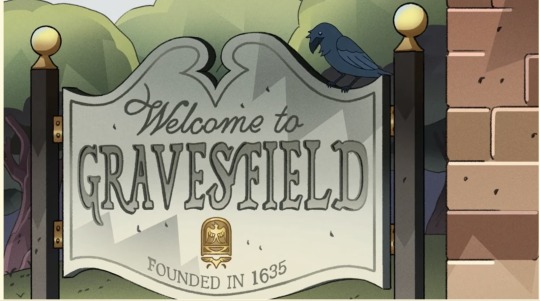
(Granted there is a difference between a settlement and a town, it is possible that 1635 was when Gravesfield was officially acknowledged as a town and the boys just lived there pre-establishment).
However, in the name of historical accuracy, I have to assume Masha got the date wrong, because the English didn’t even settle in Conneticut until the 1630s. The Conneticut Witch Trials began in the 1640s. By this timeline and demographic, the likelihood of Caleb and Philip being Puritans goes up by a lot.
However, if we look at Philip’s clothes an his goals, there are still signs that don’t point to Puritanism. First look at the clothes Caleb and Philip wear as children:
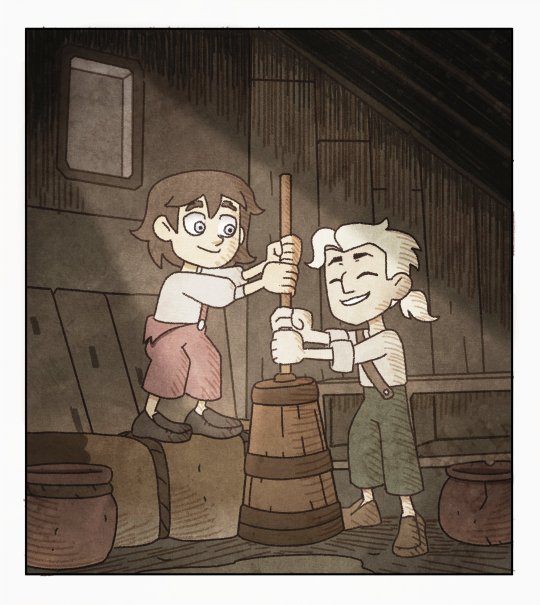
Philip’s pants are red and Calebs are green. While it is a myth that Puritans could only wear black, the colors that they were allowed to incorporate into their wardrobe were typically still neutrals (dark yellows and beiges). Green would be pushing it, and red would be unbelievably bold.

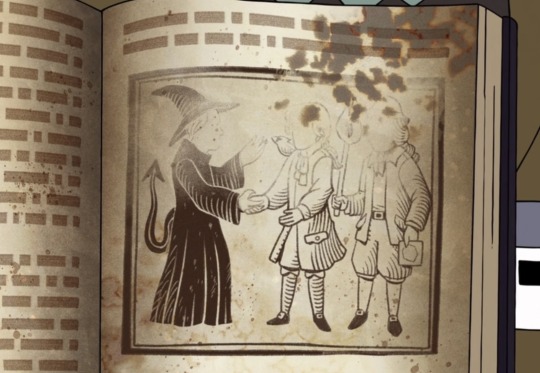
Additionally, the ruffles on Philip’s shirt in the journal and Jacob’s book, would have been seen as incredibly vain.



The blue/black coat that Caleb wore in the puppet show, and Philip later wears in Elsewhere and Elsewhen and King’s Tide has gold buttons and gold embroidery. Gold and Silver accessories of any kind would have been considered incredibly sinful and conceited.
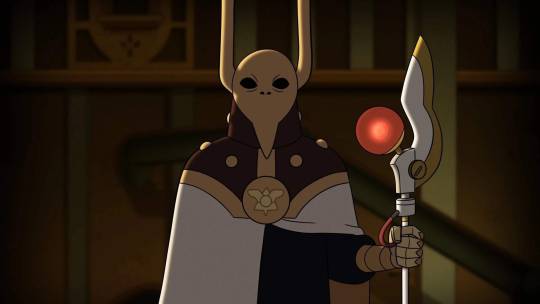
Which would also make it really weird for a Puritan to choose gold to represent himself. Infact his whole emperor authentic is much more reminiscent of the Catholic Pope. His own role as the messenger of the Titan’s will is also very papal in nature.
Finally there is the term he uses, “Witch Hunter General” is an illusion to “Witch Finder General” which was a rank made up and used by Protestant Matthew Hopkins and not really used by any Puritans. Such a title would also probably have seemed pretty vain.
Now you might say, “It’s a fictional story, why does any of this matter?”
The answer is: It does not, but I am high and have ADHD and this was the rabbit hole I fell down.
#the owl house#owl house#toh#wittebros#wittebane brothers#philip wittebane#caleb wittebane#witch trials#witch hunts#history#belos#emperor belos
574 notes
·
View notes
Text


Rare Coins and Treasures Discovered at Greece’s Ancient City of Tenea
Archaeologists in Greece discovered a hoard of rare ancient coins and other treasures at the ruins of Tenea, near Corinth, a city that was built by Trojan prisoners of war.
The Ministry of Culture announced on Tuesday that the recent excavation unearthed 29 silver ancient Greek coins dating from the late 6th century.
Several are among the rarest and most historic coins of ancient Greece, the ministry says.
Rare silver coins unearthed at Tenea
They include three staters of Elis minted at Olympia during different Olympic Games, staters of Aegina with a land instead of a sea turtle, staters of Stymphalos, Argos and Opuntia Lokron, as well as staters of Thebes from the 5th century BC depicting Hercules suffocating two snakes with his hands.
The stater, as a Greek silver currency, first as ingots, and later as coins, circulated from the 8th century BC to AD 50. The earliest known stamped stater (having the mark of some authority in the form of a picture or words) is an electrum turtle coin, struck at Aegina that dates to about 650 BC.
The treasure is linked to the finds of cult use (female and animal figurines, miniature vases and others) that were identified last year and continued to be identified this year, giving a clear ritual character to the areas that are revealed the announcement says.


Other stunning discoveries
The excavations at Tenea also revealed a section of Hadrian’s aqueduct, determining the course of one of the largest hydraulic works of the 2nd century. A.D. in Greece.
Also, part of the prehistoric settlement of Tenea, dating to the Early Bronze Age II (2,600 – 2,300 BC), was identified and excavated, confirming the area’s habitation before the fall of Troy.
In addition, a rich building complex from the late Archaic times to the Hellenistic times was revealed, with individual areas of cult use between them and three extremely well-maintained tanks, one of them with a descending-ascending scale.
The new excavations brought to light dozens of ancient pots and figurines.


The ancient city of Tenea in Greece discovered in 2018
According to Greek mythology, Tenea was established by Trojan prisoners of war who were granted permission by King Agamemnon to build their own settlement after the Trojan War.
The city’s location, roughly 15 kilometers (9.3 mi) southeast of Corinth and 20 kilometers (12 mi) northeast of Mycenae, made it an important crossroads for trade and communication.


In 2018, a team of Greek archaeologists led by Eleni Korka made a remarkable discovery: the remains of ancient Tenea, previously thought to be a mythical city.
The first excavations revealed a vast necropolis, or cemetery, dating back to the 4th century BC to the Roman era. Among the unearthed artifacts were jewelry, coins, and pottery shards, providing valuable insights into the city’s history and culture.
By Tasos Kokkinidis.

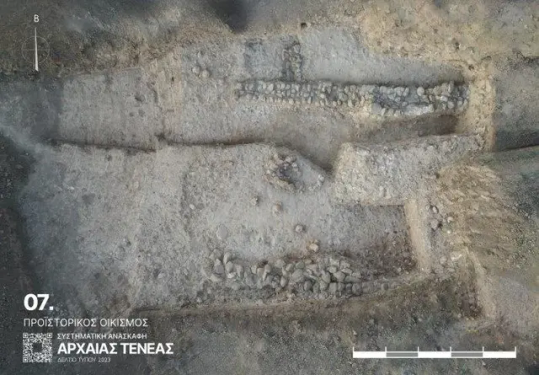
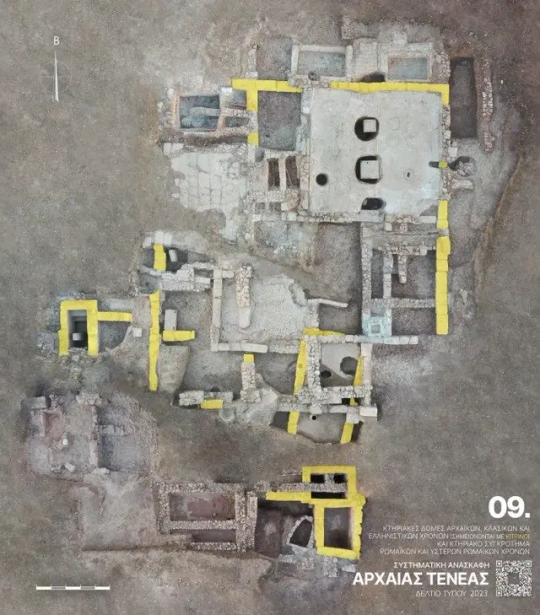
#Rare Coins and Treasures Discovered at Greece’s Ancient City of Tenea#Greece’s Ancient City of Tenea#silver#silver coins#ancient coins#ancient artifacts#archeology#archeolgst#history#history news#ancient history#ancient culture#ancient civilizations#ancient greece#greek history#greek art
48 notes
·
View notes
Note
Is there anything about your new location (the terrain, the local culture, the physical sites, etc) that has given you a new perspective on regional events of the War of 1812?
This a wonderful ask, thank you! I have been mulling over how to answer it all day! This ended up getting so long I put it behind a cut (I HAVE A LOT OF FEELINGS ABOUT THIS).
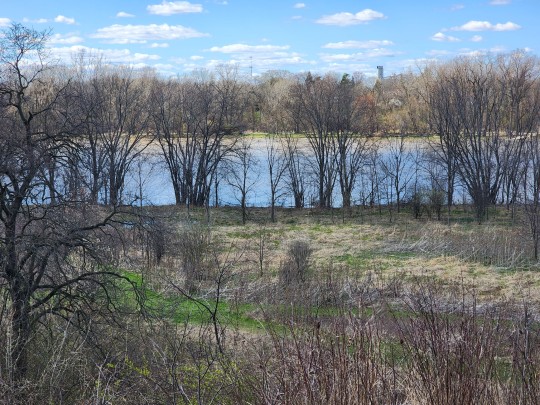
The Maumee River, as seen from Fort Meigs Historic Site.
One thing new in my life is a heightened awareness of important rivers facilitating the movement of trade, supplies, and settlement. Particularly in the Old Northwest/current Midwest of the USA: regions that I grew up perceiving as a land-locked "flyover country."
Like, to give one example, I had a vague idea that there was a city called Fort Wayne, Indiana, but I thought it was just in the middle of a cornfield for no reason(?). But actually it's at the confluence of the St. Joseph, St. Marys, and Maumee Rivers, leading to the Great Lakes! The strategically important location is why General Anthony Wayne—that guy again—built the original fortification in 1794. I am downriver of all of this, connected to many inland waterways.
I also have a keen sense of living in the Great Black Swamp, despite how dramatically the land has been transformed by deforestation and drainage. There are the terrifying drainage ditches everywhere (the locals seem less perturbed by them), and many other signs of the natural state of the terrain—the swamp is just barely at bay. My coworkers have said "Black Swamp" unprompted in our conversations; I've seen it mentioned in local Facebook groups talking about the need for back-up sump pumps. The idea that people of northwest Ohio have no sense of history and are unaware of the Great Black Swamp isn't true at all.
I look at the pools of water that form in every hollow and think of the words of Alfred Lorrain, marching to Fort Meigs:
We had frequently to pass through what was called, in the provincialism of the frontiers, "swales"—standing ponds—through which the troops and packhorses which had preceded us had made a trail of shattered ice. Those swales were often a quarter of a mile long. They were, moreover, very unequal in their soundings. In common they were not more than half-leg deep; but sometimes, at a moment when we were not expecting it, we suddenly sank down to our cartridge-boxes.
Swale is a new word in my vocabulary, and now I see them everywhere!
Culturally, I think there is a great appreciation of history here: a very positive difference from the Chicagoland area. Even if the average local is probably not deeply into it, they have a consciousness of major historical events that have shaped their region and take pride in it. It's a lot more like New England that way.
Because of my focus on the War of 1812, I notice the absence of Indigenous people and voices—absent from historical accounts and from the demographics of Perrysburg and its environs today. I can't single out Ohio as being a uniquely violent settler-colonial state when this is ALL of the United States; but it hits different when I have this much greater familiarity with who was forcibly removed from this land, and how. The same US military leaders who fought in the War of 1812 were behind the (very much related) campaign for the removal of Native Americans from newly acquired territories, including the infamous Trail of Tears.
Once again, it's probably hypocritical for me to notice this so much, when I literally grew up on Wampanoag land where King Philip's War was fought, but here I am. Suddenly aware of General Wayne's name on everything, etc.
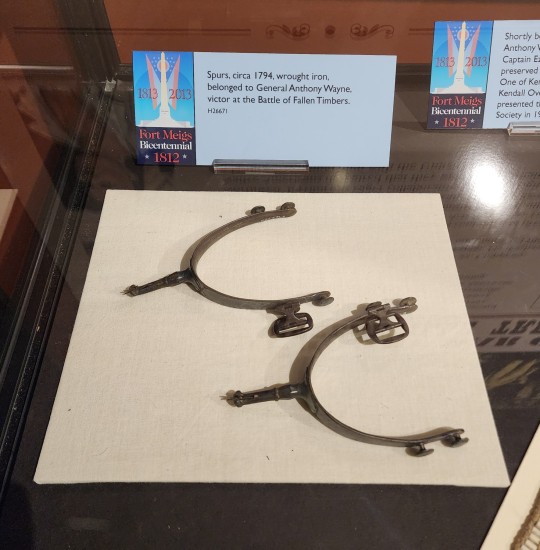
General Wayne's spurs in the Fort Meigs Museum. Not pictured: the can of Maumee Bay Brewing Co. Fallen Timbers Ale that I am currently drinking.
I haven't had the chance to explore physical sites with historical significance beyond Fort Meigs and Fallen Timbers. I know I will get to the ruins of Fort Miamis soon, and I really want to explore a lot of wetlands in local parks and nature preserves (that will double as birdwatching excursions). I am always thinking about what this place looked like 200 years ago, and what I can see today that might still look familiar to a person from that time.
I had a great trip to the National Museum of the Great Lakes today, which is closer than I thought! Local maritime museums are also on my agenda, even if they're not specifically War of 1812-related.
#asks#shaun talks#ohio posting#i could add three or four more paragraphs to any given paragraph here#you activated my trap card
22 notes
·
View notes
Note
im curious-what non-death scenario do you imagine for anora if alistair becomes king without her? i'm trying to figure it out in one of my worldstates but all i can come up with is exile, which while potentially interesting, is not what im going for personally
if anora’s character permitted her to reach some kind of settlement, i could see her retaining her father’s title and becoming teyrna of gwaren. frankly i think it’s incredibly unlikely that she would never raise rebellion against alistair, because her determined belief that only she can lead ferelden successfully is integral to her character, and she’s such an obvious candidate for anyone who has cause against alistair. (it’s impossible for a king not to create such enemies, especially one as inexperienced as alistair, as clearly reliant on one or two particular advisors, and (optionally) as dedicated to the controversial goal that the warden’s requested boon can often be.) however i think it’s also worth noting that it’s historically way more likely than you’d think for rebellions to end in the king offering mercy. not to go on a nerd tangent, but viewing ferelden as an early medieval kingdom, this is actually part and parcel of how chivalric culture + the church facilitated peace prior to the end of chivalry + the onset of religious warfare in western europe, and i would expect something similar. i could see anora leading a rebellion that actually ends in alistair victorious and that being how he gains anora’s respect in a very mac tir way, and that actually leading her to accept a gwaren settlement. just throwing that out there as a fun little plot concept
i could see her marrying to consolidate her position—fergus cousland being an obvious option here—but i think it would be a bad move for the crown to permit that. (i don’t know what the lore is for this in ferelden, but typically noble marriages are going to need the king’s permission, and absolutely when it involves powerful landowning widows.) i can’t overstate how overpowered the couslands are and what a challenge fergus and anora could pose together to the crown. that’s both a reason not to let them marry and a reason it would be hard to stop them. all this assuming this is even in fergus’ interests. otherwise i can’t think of anyone eligible in ferelden who is both powerful enough to make anora consider a marriage and not loyal to alistair, so if not fergus she’d probably have to look abroad, which seems unlikely for her character (marrying a non-fereldan? sharing her land rights with a non-fereldan?) and would definitely be a mark of desperation if it did happen
those are some casual thoughts anyway
#anora mac tir#i havent been up for long if any of my history notes here are baseless generalisations its not my fault
88 notes
·
View notes
Text
Lexember #6-8: Tsaltep, Kyeng, Ngûp

Above: Left: Tsaltep (caltep), Right: kyeng-ngûp.
Let’s get into political history. The cal-tep [tsaltɛp˺] refers to the ruler of Milim before Tepat conquered it.
Althought the end sounds like Tepat, they aren’t related, that we know of. It is typically spelled with the phonetic tep which means ‘enemy.’ Obviously, Tepat doesn’t call itself ‘enemy.’ (Sometimes hostile neighbors make the connection and spell it that way as a joke.)
The first part cal may be spelled with the phonetic chyal ‘to fly.’
We don’t know the origin, which must be from the poorly known Milim language. One hypothesis is that it means “liontamer” and refers to an annual ceremony where the king executed a captured lion to show how badass he is.
More about ancient “lions” in Tepat:
https://www.tumblr.com/yuk-tepat/669739776543424512/lexember-4-5-yap-and-yaput?source=share
Of course, since the word Tepat itself is probably of Milim origin, they might be related.
Milim rulers are usually referred to in Tepatic chronicles as Tsaltep only, and distinguished by number. The last 10 rulers, who oversaw the largest human sacrificial system in history, are known as the “Ten Forgotten Names,” as a form of punishment, with the hope their spirits will be extinguished with their names. Historical records of the Milim were vandalized, often only being rediscovered and reconstructed recently.
Read more posts about the Milim:
https://www.tumblr.com/yuk-tepat/search/milim
Then there’s the kyeng-ngûp [kjɛŋgɯp˺] ‘followers and allies,’ the nobility of feudal Tepat. They derive from the Tepatic conquest of the Milim potamocracy. Milim gained contol over many towns and tribes which were known as ngûp or ngyûp. Milim demanded captives of their vassals, which they sacrificed in the Tsaltep’s necromagical project to extend his life in Bathoryesque fahion. It kept the vassals in line but engendered bitterness.
When Womuq was sent out from Notoq, he established a settlement on the plain (Tepat), which was in the sphere of influence of the Milim. After escaping a tornado, and rescuing the daughter of a ngûp chief, who was to be sacrificed to the Wind God, he learned of the Tsaltep’s crimes against humanity. Taking his chance to overthrow them, he assembled a force of his most loyal retainers (the kyeng) to march on Milim. Along the way, he was assisted by resentful local ngûp.
When Womuq prevailed over the Tsaltep, he restored to ngûp chiefs their traditional bases, and he distributed the rest of the Milim territories to his warrior-followers as estates. These early followers with their land formed the core of the Nyow-era aristocracy, and their descendants claimed land and rights in perpetuity on account of this. Hence the entire aristocratic system is known as kyeng-ngûp.
22 notes
·
View notes
Note
medieval chess au….? that sounds so cool
so originally i wanted to do some kind of historical au for chess set during the medieval era, but the more i looked into it the more i realized that trying to do something like that in a real world context while still keeping the same real world political context (apolitical chess is just not as interesting to me tbh) just wasn't going to work, so instead i decided to do what george r.r. martin did when he was writing game of thrones and use real world history (game of thrones was largely inspired by the war of the roses) and real world politics within the context of a fantasy setting, so the main conflict is still east vs west, but it's the eastern kingdoms vs the western kingdoms.
freddie is ser fredrick, the gilded lion, born and raised in the golden city (the main seat of power among the western kingdoms similar to king's landing, located by the sea) to become king, beloved by most while also being regarded as a petulant child that (seemingly) hasn't had to deal with any real hardship, and then across the emerald sea are the eastern kingdoms, a colder, harsher climate compared to the western kingdoms, which is where prince anatoly, the black prince (or the white wolf, depending on who you talk to), lives with his wife, svetlana, and his advisor, aleksander molokov, who himself was born in the small settlement of alexandrovitch, located just outside the black gates, which separates the northernmost mountain range and the freefolk lands from the rest of the southern kingdoms. florence, meanwhile, is ser florence, a former advisor and freddie's royal mistress whose family comes from the eastern kingdoms but grew up in the golden city before deciding she was fed up with her life and ran away to become a knight instead, and then other plot details that include things like anatoly abdicating the throne because he never wanted the responsibility of ruling a kingdom and leaving his wife to take over the responsibility instead as the czarina and her doing so knowing that there are people who depended on them for leadership and guidance (and honestly probably being better at it than he was), molokov secretly plotting to take over the throne for himself (having already earned himself the nickname of the wolf whisperer), freddie regularly competing in the tournaments held in the golden city and being a very capable warrior in his own right (he's big on jousting).
#typing this with a fucked up hand because i got way too excited thinking abt never play to win a pawn aka game of chess#so far most characters and locations have a corresponding game of thrones equivalent that served as its inspiration#like how molokov is basically petyr baelish#or how florence leaves to become a knight like brienne of tarth does#the eastern kingdoms are very much patterned after winterfell and the wall in addition to its real world equivalent of russia#as well as other slavic countries#while the western kingdoms are patterned after king's landing and the vale and highgarden#as well as mountains and forests and some of the deserts found here in the states#i still don't have Everything but i also just haven't worked on this in Awhile#but it's definitely one of my favourite aus i've ever worked on tbh#answered#nickclose#chess the musical#never play to win a pawn tag#the tirolean spa (my brain) once again has the chess boys in it#i also have a drawing of knight!anatoly somewhere if i can find it 👀
21 notes
·
View notes
Text

The Igbuzo (Ibusa) Kingdom:: Tracing the Roots of a Brave Igbo Community in Delta State, Nigeria"
Igbuzo, also known as Ibusa, is a vibrant Igbo community nestled in Delta State, Nigeria. Its roots can be traced back to around 1450 when waves of Igbo migrants embarked on a journey westward, ultimately leading to the formation of Igbuzo.
The name "Ibusa" is derived from "Igbo bi n'ụzọ," meaning "Igbos that live by the wayside" or "Were you the first to settle here?" This moniker was bestowed upon them by neighboring communities such as Ogwashi-Uku, Asaba, Oko, Ilah, and Okpanam, as well as European missionaries who struggled to pronounce the community's original name.
Historians believe that a group of settlers who embarked on a journey from Benin alongside Ezechima, heading eastward, may have found their final settlement in Igbuzo. It is speculated that these settlers, either due to illness or a lack of interest in continuing their journey, assimilated into the existing Umejei and Edini groups in Igbuzo.
Ibusa comprises two distinct units: the Umejei and Ogboli settlements. According to oral history, Umejei Nwa Eze Isu, the prince of Isu, was involved in a wrestling bout that resulted in the death of his opponent. Traditionally, this act was considered an abomination punishable by death. However, Umejei's father, the king of Isu, commuted his son's sentence, and Umejei was exiled with a gourd given to him by his father. He was instructed to settle wherever the gourd dropped, leading him to establish Igbuzo at the present site of Ani-Oshe in Omeze.
In another tale, Odaigbo of Nshi (Nri) had relations with one of his father's wives, which usually carried a mandatory death sentence. However, Eze Nshi spared Odaigbo's life and instead exiled him, accompanied by his father, mother, and younger brother, Edini. Each of them carried a pot and charms, instructed by Eze Nshi to settle wherever the pot fell. Edini's pot landed at Ani-Nshi (Nri) Ogboli in Ibusa, while Odaigbo's pot dropped at the current site of Ogwashi-Uku, where he settled. The groups of Edini and Umejei eventually merged to form Ibusa, with the Ogboli community becoming part of the larger Nri (Nshi) community.
Ibusa is renowned among the Igbo and Anioma people of Delta State for their courageous spirit, often described as "Isu (Igbuzo) fu ogu ju nni," meaning "Ibusa people who refuse food to fight wars." This statement exemplifies their bravery in times of conflict. Researchers are currently delving into the history of wars fought by the Igbuzo people, particularly in the homes of their kinsmen in Nnewi, Anambra State, to uncover any historical connections between the two communities.
41 notes
·
View notes
Text
Where do you live in The Tectomancy Saga?

Pick what sounds nicest from the options below to find out which major settlement you live in from the world of The Tectomancy Saga!
Locations and descriptions unveiled below the cut!
1. Leirsham
You live in the ringed city of Leirsham, the human capital. It's built into a hilly island, raised out of Lake Simul a millenia ago by King Artol Tectus. The city falls in tiers, rings around the island divided by walls; The docks and storehouses; the merchants' district; the residential area; the academics district; the upper city, and the palace. As a hub of human trade and travel across the gigantic lake, it's always bustling!
2. The Genom University
The Genomic people take 'university city' very seriously. The entire city is a university filled with lecture halls and libraries and laboratories, where Genemos study hoping to attain their people's divine magic through rigorous scientific research. Its central feature is the archive, a library where all of Genomic history is stored - through the power of conjuration, this is quite literal. It is said that entire historic buildings can be summoned from the archive.
3. Ipurrol
Ipurrol lies in Versewelt, near the edge of the world. It was cut off from the rest of human civilisation 400 years ago, when a plague swept the land, turning its victims into various forms of bloodthirsty ghoul. Those who remain have learned to live with their condition and keep living on, rebuilding their community together. The Vismoores are the local nobles, who live alone in the castle that looms over the village - even among oddities, those two are odd.
4. Athyran
You live in the Alvian city of Athyran. On its surface, surrounded by desert, its grand architecture dazzles tourists, and baffles them by appearing to be abandoned; most of the city resides below the surface in cool caves, hidden by an illusion. The buildings extend below the earth, making it a forest of towers among glowing formations of crystals. Their cuisine is quite mushroom-heavy. This city represents the centre of the 'pattern' which Alvians bury their dead in across their lands.
5. North's Edge
North of human lands, in arctic tundra, wintery wastes, and snow-covered rocky mountains, the Droichs live in peaceful alliance with Dragons. The Dragons fled from humanity, their former allies, 900 years ago, and formed a partnership with Droichs. The Droichs mine to maintain the dragon's scales and hides with metal and stone; the Dragons serve as defence and transportation for the Droichs. They make their home nestled into a cave-pocked ravine, where Dragons and their Droichish riders gather around the fire together.
6. Hell
The Demonic city of Hell is far below the suface, near the very axis of the world. Its sloping side is marred with holes like a honeycomb, through which the swirling blue mists of the edge of the world creep. Lit by glowing plants and lava flows, the city is built into the rock like a warren, with only gothic spires and roofs peeking out above the ground. Due to the Demonic magic of enchantment, you have to be very careful who you talk to and what you say. Demons though, have this down to a fine art, and natter endlessly to each other.
7. The Hollow
Formally 'Colossus' Hollow', because it looks like a giant kicked a huge hole in a hill and people built a city there. Sat on the border between human lands and Alvian ones, and with a clear view to the Arboric Ocean, just about anyone and everyone could turn up there. With nobody quite able to lay a claim to its leadership, it is more-or-less ruled by an organised crime gang known as 'The Robes'. Their own operations take place in other cities, but their rules for everyone else just say "If you fuck this place up for everyone else, we're coming for your head."
8. Gorzlun Kudh
One of the largest Orken communities; its name means 'Risen City'. Made almost entirely of drenchwood, a form of moisture-resistant wood, it rises out of a great swamp on thick stilts. It is home to the Oracles, wizened Orken elders who have practised the art of future-sight for centuries. It is also home to the battle-mothers, and their endless raiding gangs of battle-sisters. Most older Orkus remember a time when it was not like this. They farmed, they relaxed, they made things with their hands, and they helped their neighbours. Maybe one day it'll be like that again.
#writeblr#the tectomancy saga#writing#bbs&b#mwc&c#made with crown and claw#writing fantasy#writers of tumblr#writeblr poll
9 notes
·
View notes
Note
I appreciate the counter-revisionist spirit of the Puritans but it doesn't fully acknowledge the bad with the good, right? The Puritans were genocidal towards Native Americans (during Metacomet's War), supported slavery, and then there's the brutal campaign in Ireland under Cromwell that ended with many poor Irish reduced to indentured servitude.
So I think this is a very fair critique. If I'm going to take the position that we have to acknowledge that tumblr's faves the Vikings and Caribbean pirates were heavily implicated in slavery, I think it's incumbent on me to recognize the intense violence that was also part of the Puritan legacy.
Because I think there's a direct line that can be drawn towards the violence of King Metacomet's War, the violence of Cromwell's campaign in Ireland, the violence of the English Civil War, and the violence of the wars of religion on the European continent, in part because in some cases you literally had veterans of one conflict fighting in another, and also because I think it points to the ways in which these conflicts fit a rather conventional pattern of 17th century warfare. This is not to say that the Puritans' actions were moral, but rather that they weren't unusual.
First, these wars tended to involve targeted attacks on civilian populations, the tendency for both sides to engage in escalating reprisal atrocities (this is not meant as a minimization tactic: if you look at the actual conduct of these wars, there are no good guys as pretty much everyone gives into the temptation to massacre civilians in revenge), and high casualty rates.
Second, they tended to involve seizure of land and the simultaneous pushing out of existing inhabitants and intended settlement of co-ethnics/co-religionists. These wars were intended to reshape borders and frontiers in ways that we today would consider ethnic cleansing.
Third, they were also rather complicated conflicts. Metacomet's War wasn't just a Puritan attack on the Wampanoags, but a complex affair of the Puritans and nine different First Nations tribes who fought both for and against the Puritans and one another - indeed, arguably two of the biggest victors of Metacomet's War were the Mohawk and the Wabanaki. In Ireland, you had the Catholic Confederation who had originally rebelled against Charles I and warred against the largely Scottish Ulster Protestants but who also allied with Charles against first the rebellious Scottish Covenanters and then the English Parliamentarians, you had Scottish Covenenanters who sent armies into Ireland to protect and revenge their kinsmen, you had a Royalist army under the command of an Irish lord who was tasked with putting down the Confederation and then recruiting the Confederation, and then you had Cromwell's New Model Army. (This is why, for example, most of the victims of the massacre of Drogheda were English Royalist soldiers rather than Irish Catholic civilians.)
Finally, a couple points about slavery. First, it is true that slavery was practiced in Puritan New England, but unlike in Virginia, New England was a society with slaves rather than a slave society. Hence why you had odd scenarios, whereby in New England slaves had the right to jury trials - a loophole that enlaved people would exploit starting in the mid-18th century to launch freedom suits by which they would petition the court for manumission.
Second, I would strongly advise that you be very, very careful about the topic of Irish indentured servitude, because the "Irish slaves myth" discourse devolves very quickly into white supremacist propaganda, and there is a nasty tendency for Irish republicans to be extremely cavalier with racist tropes. For example, Sean O'Callaghan, the author of To Hell Or Barbados: The Ethnic Cleansing of Ireland not only conflated indentured servitude with chattel slavery, but invented a brand new historical libel when he claimed that Irish women sent to Barbados were systematically forcibly bred to African men. (Incidentally, for some misbegotten reason Wikipedia's page on the Cromwellian conquest of Ireland cites O'Callaghan as a source.) Despite the fact that this obviously trades in racist myths of black men as sexual predators, other authors repeated the claim and then it went viral online.
Not only is the conflation of temporary indentured servitude with chattel slavery something that a lot of white people use to minimize the history of anti-black racism similar to how narratives of immigrant struggles and upward mobility are used to minimize the impact of slavery and racism (essentially, we white ethnic group suffered and got over it, why can't you), but it also becomes this vector for online radicalization by white supremacists, neo-Nazis, and conspiracy theorists as memes circulate on social media forums - with the hope being that you gradually draw people from Facebook (and Tumblr?) to Infowars to Stormfront.
55 notes
·
View notes
Text

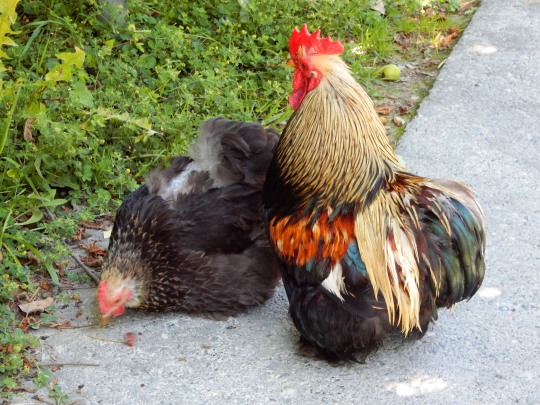




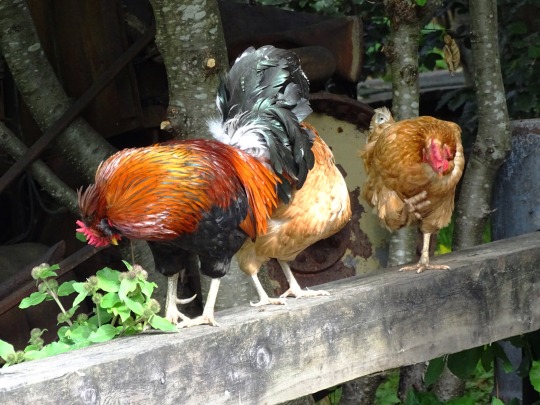







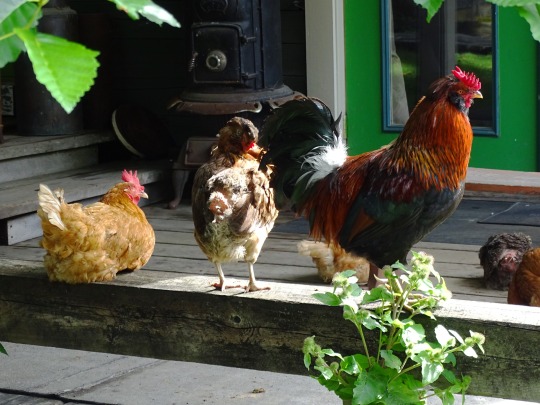
National Snuggle a Chicken Day
National Snuggle a Chicken Day is celebrated annually on January 8. Evident from the name, this holiday is a day to snuggle chickens and treat them with the same care shown to more popular pets. Interestingly, many homes do keep chickens as pets and when comfortable, chickens enjoy being petted and held by people. These feathery animals were domesticated as far back as 10,000 years ago and have been put to a variety of uses, from cockfighting to making up delicious meals. The day recognizes the abuse that chickens go through and their uniqueness.
History of National Snuggle a Chicken Day
National Snuggle A Chicken Day identifies as a nonprofit organization and the name says it all — a day to snuggle a chicken! Chickens have a long and colorful history in our world. Though they’re now commonly used for food, this wasn’t always the case. It is believed that chickens were domesticated as far back as 7,000 to 10,000 years ago. Initially, they were primarily bred for cockfighting or special ceremonies. Louisiana was the last state of the U.S. to ban cockfighting — as recently as 2008.
It wasn’t until around four B.C. — two B.C. that people began consuming chickens for food. Their eggs also became a primary source of food. Now, there are more chickens than any other bird in all parts of the world. Chickens are also pets, as they are social animals like dogs and cats. Some do enjoy being petted and picked up when they are in the company of people they feel comfortable with. Chickens have also symbolized different things in one civilization after another.
In ancient Egypt, eggs would be hung in temples to ensure a bountiful river flood. In Zoroastrianism, an ancient Persian faith, the rooster was portrayed as a spirit that crowed at dawn to signify the cosmic struggle between darkness and light. Even in Christianity, the story of Peter denying Jesus before the cock crowed led Pope Nicholas to decree that a rooster figure should be placed atop churches. This explains why many churches have cockerel-shaped weather vanes on top of them.
National Snuggle a Chicken Day timeline
7,000 — 10,000 Years Ago
The Domestication of Chickens
Chickens are domesticated in Southeast Asia and Oceania.
4 B.C. — 2 B.C.
Chickens are Bred for Consumption
People begin breeding chickens for food consumption.
9th Century
The Decree by Pope Nicholas
Pope Nicholas decrees that churches should put cockerel figures on their roofs.
National Snuggle a Chicken Day FAQs
What does it mean when a chicken follows you?
Chickens can follow you when they are hungry, especially if you are their caretaker.
What Are chickens afraid of?
Chickens are afraid of large predators like owls and hawks.
Where do chickens like to be petted?
On the head, back, neck, or chest.
National Snuggle a Chicken Day Activities
Snuggle a chicken: It’s National Snuggle a Chicken Day! Celebrate by snuggling a feathery chicken.
Buy a chicken: You can also buy and keep a chicken as a pet. They make for peaceful and fairly low-maintenance pets. Plus, they could also supply you with eggs.
Spread the word! A lot of people probably don’t know we’re celebrating this holiday. Spread the word by telling a friend or posting on social media.
5 Fascinating Facts About Chickens
They can spot differencesChickens can distinguish between more than 100 faces of their species.
They have social structuresChickens know who’s boss by forming complex social structures known as ‘pecking orders’ where every chicken knows his or her place on the social ladder.
They have complete sightChickens have a full-color vision.
They sleep like humansThey experience rapid eye movement in sleep, which means they dream just like any human.
There are more chickens than humansThere are currently over 20 billion chickens in the world.
Why We Love National Snuggle a Chicken Day
Chickens are social: Contrary to popular opinion, chickens are social animals. Some enjoy being petted and picked up, like other popular pets.
Chickens are a food source: Chickens are a healthy source of protein when used as food. Both their eggs and meat are healthy food sources.
This holiday opposes animal cruelty: People are often prone to mistreat the animals they own. This holiday is a reminder to treat animals, including chickens, with more care and kindness.
Source
#Brahma chicken#Key West chickens#Zoo Zürich#Stewart#Kings Landing Historical Settlement#Switzerland#Canada#USA#Silkie#Zurich#Schweiz#travel#original photography#vacation#tourist attraction#landmark#day trip#flora#fauna#architecture#cabin#National Snuggle a Chicken Day#NationalSnuggleaChickenDay#8 January#bird#animal#rooster#feather
2 notes
·
View notes
Text
Descendants of runaway slave communities still struggle for equality in Brazil

Down a rickety staircase into a basement workshop lined with pottery objects, Irinéia Rosa Nunes da Silva shows off a sculpture inspired by a dramatic episode for her people.
A dozen clay figures cling to trunks or branches, one with a bird in its arms. On a sweltering tropical afternoon, the septuagenarian artisan describes how this depicts the floods of 2010, when 50 residents from her village of Muquém, in the hilly and verdant countryside of northeastern Brazil, climbed up a pair of jackfruit trees and stayed there overnight to survive the rising waters.
The ceramic work is an apt memorial to the centuries of resistance by traditional rural communities known as quilombos which are scattered throughout the vast country. Descended from settlements originally founded by escaped slaves during colonial times, they have long been a symbol of struggle against oppression and hold an important place in Afro-Brazilian heritage.
Now, for the first time, a census has recorded the number of citizens who belong to these socio-ethnic groups. Quilombolas, as they are called, numbered 1.3mn in 2022, according to the Brazilian Institute of Geography and Statistics. At 0.7 per cent of the overall population, they are not far behind the 1.7mn indigenous Brazilians. “Before we didn’t have this identification of our ethnicity or culture,” says Dorinha Calvacanti, the head of a residents association in Muquém. “It was a very important milestone.”
The community of 800 quilombolas in the state of Alagoas traces its origins back to the largest and most famous quilombo, Palmares. During the 17th century, Palmares grew into an autonomous confederation of settlements over mountains and forest. At its peak, there were an estimated 20,000 inhabitants, including runaway slaves, native people and white Europeans. Its last ruler, Zumbi, repelled numerous attacks by Portuguese forces before the kingdom’s capital fell in 1694, and was killed a year later. Following the abolition of slavery in 1888, the warrior king became a hero of the 20th century Afro-Brazilian political movement. The date of his execution — November 20 — is celebrated as Brazil’s Black Consciousness Day.
Despite their belated recognition in today’s records, just under 3,600 self-declared quilombos continue to be afflicted by poverty, unemployment, discrimination and poor access to public services. Historically marginalised, few possess land titles. Even if the census data helps deliver better public policies, the long wait for inclusion is “a symptom of the structural and institutional racism of the Brazilian state”, argues professor Vagner Gomes Bijagó at the Federal University of Alagoas. “These challenges greatly impact the preservation of quilombola culture.”
Continue reading.
#brazil#brazilian politics#politics#antiracism#quilombos#mod nise da silveira#image description in alt
13 notes
·
View notes
Text
Both oral traditions and archaeology suggest that warfare was rife in the sierra from Ecuador to Argentina after ad 1200 or a bit later. Many communities settled on the peaks in protected villages well above the best farmlands. Some of the most powerful societies of the time, including the Lupaqa and Qolla, lived around Lake Titicaca. In the early Colonial era, they called their pre-Inca rulers kings, but they do not seem to have attained a state level of organization. Instead, the region’s societies seem to have lived in considerable instability, in which local conflict played a major role in both begetting chiefly alliances and fracturing polities (Arkush 2011). Radiocarbon dates suggest that the settlement pattern shifted radically about ad 1300, which may have been a result of a significant growth in conflict among neighboring communities (Arkush 2011). Groups living in the populous Peruvian sierra, such as the Wankas, lived in towns that contained as many as 4,500 densely packed circular houses and may have housed 10,000 or more people. Significantly, the shift to defensively situated communities occurred about the same time in that region as had occurred in the Titicaca area, suggesting that similar processes were in play in both areas (D’Altroy et al. 2001). In the south Andes, the largest towns contained a few thousand people, but regional polities still held no more than 20,000.
==========
Linguists have recently arrived at the view that the Incas may have adopted Quechua for imperial rule precisely because it was already widespread. Before then, the Incas spoke one or two other languages, most likely Aymara and possibly Puquina.
==========
The language that the Incas used to administer their domain is commonly known today as Southern Peruvian Quechua, but its speakers knew it as runasimi, or human speech.
==========
The term Quechua itself was probably imposed early in the Colonial period by Spaniards who mistook the word qheswa (valley) in the phrase qheswa simi (valley speech) for the name of the language (Mannheim 1991).
==========
Quechua was entrenched by 1532 as the language in which all official business was supposed to be conducted.
==========
the home region of Quechua lay along the central Peruvian coast (figure 2.6a). The language had split into two major branches and was already widely distributed in the highlands at least five centuries before the Inca rise to power. The variant that the Incas adopted appears to have been Chincha Quechua. Its roots lay on the south-central coast, but it was used in parts of the Andes from Ecuador to south Peru (Adelaar and Muysken 2004). The Incas’ major contribution to the geographic spread of this form of Quechua was in the south Andes, and even some of that distribution can be attributed to Spanish Colonial practices (DeMarrais 2012).
==========
Drawing from historical linguistic and toponymic (place-name) evidence, some linguists suggest that the Incas probably spoke Aymara well into the early imperial era, since that was the language of the southern Peruvian highlands in late prehistory and Aymara place-names are even found as far north as the central Peruvian highlands (Adelaar and Muysken 2004; Cerrón-Palomino 2004, 2008; Heggarty and Beresford-Jones 2012; figure 2.6b). Quechua and Aymara speakers apparently interacted a great deal, to the extent that the two languages now overlap about 30 percent (e.g., in lexicons)
==========
The leading Andean linguist today, Rodolfo Cerrón-Palomino (2012), suggests that the shift may have occurred as late as the rule of Wayna Qhapaq, that is, no more than three or four decades before the Spaniards’ arrival, because its widespread use in the lands to the north made it an effective sociopolitical tool. Intriguingly, a few chroniclers (e.g., Garcilaso, Murúa) reported that the Incas maintained a secret language that only they were allowed to learn. Many scholars have dismissed that idea as fancy, but those who accept its existence have settled on Aymara or Puquina as the most likely candidates.
==========
key Inca terms for sacred places (the capital qusqu, lake Titicaca) or beings (e.g., the Sun deity Inti) arguably have Puquina origins or were filtered through mixed Aymara–Puquina structures (Cerrón-Palomino 2004, 2012).
Terence D'Altroy. The Incas. Second edition.
20 notes
·
View notes
Text
One of the ideas and changes I often think about is what can be done to make Kingdoms actually feel like different places. Why are they different places in the first place? Show sort of gives bits and pieces of that to Atlas but beyond that it might as well be Vale1, Vale2, Vale3, etc.
The idea I settled upon is basically building each Kingdom as something very different from the ground up, creating clear reasoning for the divisions and differences as well as establishing each Kingdom's flaws.
For example:
Vale
Vale was an old monarchy ruled by a royal bloodline that started with The First King of Vale who is said to have played a major role at the dawn of Ever After when the Kingdom of Vale was founded from the ashes of previous age. History books day that after an order of scholars, known as The Emerald Circle, devised effective countermeasures, The First King personally led an army pushing back countless hordes of the Grimm that covered the continent, establishing protective lines and Kingdom's defenses. The bloody campaign of war where thousands perished so millions could live is known in the history as The First Crusade. After the situation stabilized he promptly ruled with the advice of his seers.
Now, nobody knows exactly how much truth there is in the written history of that period because rulers, monarchs, leaders, when overcome with pride tend to turn history into tales of their own greatness, going as far as even personally believing in them. The First Crusade could have been a grand campaign against the creatures of Grimm or it could have been just one king's conquest of surrounding lands, nobody would know.
Still, the kingdom persevered for centuries under this rule. The King would lead the armies against the Grimm and make political decisions while the scholars and the seers would pen the governing decisions.
The status quo lasted till the rule of The Third King of Vale, whose short-sighted egotistic decisions led to one of the most heinous events in the history of Remnant known as The Third Crusade. The years leading to the Third Crusade saw the bloody end of the Emerald Circle, deterioration of the living conditions and the patchwork being made for the death and suffering of the campaign itself. The years after saw hunger, illness and even more death. The creatures of Grimm once again wandered closer to the human Kingdom with the first known historical record of the sighting of a lone Goliath. It was the beginning of the period in Vale's history known as the Hundred Year Famine.
By the time Fourth King came into reign, the population was tired and fed up and the slowly brewing revolution came to fruition. The Fourth King, with his execution, being the last monarch of Vale.
The Third King's name was erased from the history books, the only reminder of his rule being the destroyed monuments and the words "The Third Crusade" that became synonymous with the possible evil within human nature and the terrifying irreparable damage humanity can cause.
The consequences of his rule, however, could never be erased. Vale lost much of its territory to the encroaching creatures of Grimm, attracted by the turmoil of both the third Crusade, century of famine that followed and the bloody revolution. Multiple settlements, both within Vale and around, were in ruins. And the lush farmlands in the east of the continent were lost to the Grimm completely.
The ones mapping the Kingdom's future swore that there would never be a repeat as it was a miracle the Kingdom was still standing after everything.
The Kingdom Of Vale from that day forward was ruled by a government body known as The Council of Vale. Anyone could be elected regardless of their background or status. The government structure was intentionally designed in such a way that no single council member could attain power over others and all and any major decisions had to be made in unison. All forms of slavery were abolished and a plan was enacted to provide help and reparations for the still remaining countless people displaced by the Third King's madness.
Still even though officially all are equal under Vale's laws, the kingdom is far from perfect. The history of past tragedies created an environment where people grew obsessed with status quo, even if the situation demands change. And for all the grandstanding, after the Great War, the Kingdom was still willing to turn the blind eye to less than savory elements both within and without, making business with Schnee Dust Company in spite of rumors of them "employing" slaves, as well as trading and engaging in diplomacy with Mistral in spite of the Kingdom only having changed on the surface, the power still being in the hands of pretty much same noble families that started the Great War. Slowly the slogan of never repeating the past got twisted into the very concept of demanding change being demonized.
A kingdom so petrified by fear of things getting worse and so enamored with the illusion of "the now" that it was blinded to what's transpiring behind the curtain till it was too late.
12 notes
·
View notes
Text

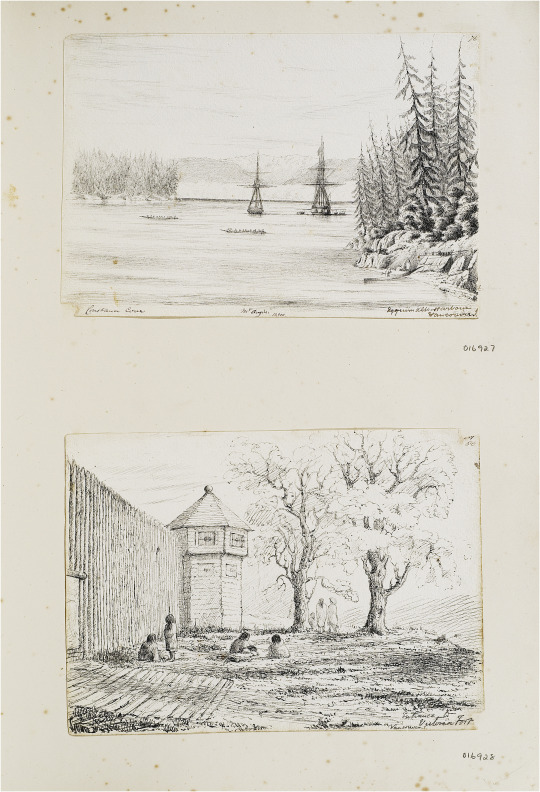


John Linton Palmer, Views near Fort Victoria, June–July 1851, pen and ink, From Chile to the Arctic Album, F030/4 © RGS-IBG.
First plate, top: Esquimalt harbour, with Constance Cove, and Mt Angeles in the distance.
First plate, below: ‘Entrance to Victoria Fort’.
Second plate, above: ‘Fort Victoria, Vancouver I.’.
Second plate, below: ‘From landing place at Victoria Fort’ [original caption].
Third plate: Sketches of people and artefacts, Vancouver Island, June–July 1851.
Fourth plate: Tomb of King Freezy’s brother at the entrance of Victoria Inlet, B. Columbia, 1851′.
"In considering such archival images as traces of encounter, contemporary historians would of course seek to adduce more evidence about the meanings of such events for the participants, in this case both British and Hawaiian, situating these events in their time and place. From this perspective, the rituals of diplomacy, the expectations of the various parties, the knowing and unknowing ways in which these events were described, would all need to be investigated. The same is true of the many other examples of the art of encounter in Linton Palmer’s albums. From an art historical perspective, such imagery would also need to be carefully contextualized with reference to matters of style, genre and perspective. In many cases, as I have argued, the influence of the naval tradition of maritime view-making is clear. However, there is another way of seeing these visual archives, especially when encountered from a heritage perspective, in which the informational content – the documentary detail – may matter even more than the point of view.
In order to substantiate this final point, we should return to Linton Palmer’s Fort Victoria sketches. Fleeting views they may have been, but in their attention to detail – whether the rendering of the hair and adornments of the people he encountered, or the material evidence of Indigenous presence in the landscape – such pencil sketches by naval visitors sometimes record what other contemporary documents do not, and in ways that can be located precisely in space and time. The matt lodges around the Fort, the cedar plank houses across the harbour, a fishing station in the distance: all these features signal an active Indigenous presence at a particular moment preceding a disastrous era in the history of the Indigenous people of what became British Columbia. Since they were first made available to First Nations historians following their exhibition in a 2009 RGS-IBG exhibition (Hidden Histories of Exploration), Linton Palmer’s images have entered the visual archive of Indigenous history and made more widely available in digital form. In particular, they have been incorporated into understandings of local settlement history by Grant Keddie, a curator at the Royal British Columbia Museum in Victoria. As Keddie’s work indicates, there is an ‘archaeological’ way of reading such documents, cross-referencing with other sources of evidence about the precise geography and chronology of landscape change. As is clear from the contemporary significance of the Indigenous sites sketched by Linton Palmer, such work is far from merely of academic interest. In 2001, 150 years after the brief visit of HMS Portland to Fort Victoria, a claim was filed in Canadian courts asserting that the land on which the Parliament of British Columbia was built (near the original Fort) had originally been occupied by or promised to First Nations peoples. After a long and contested legal process, the Ministry of Aboriginal Affairs and Reconciliation eventually reached an out of court settlement with the representatives of the Esquimalt and Songhees nations, which has been valued at $31.5 million dollars. In this context, mapping the precise geography of Indigenous settlement in space and time mattered a great deal: in fact it truly was the multi-million dollar question. And in the process, as researchers and consultants pored over long forgotten maps and drawings not unlike Linton Palmer’s sketches, the visual archive of travel acquired a new value."
- Felix Driver, "Material memories of travel: the albums of a Victorian naval surgeon." Journal of Historical Geography 69 (2020): 53-54
#linton palmer#historical geography#art album#royal navy#vancouver island#victoria#settler colonialism in canada#settler colonialism#indigenous land claims#indigenous history#british empire#canadian history#academic quote#first nations#indigenous people#british columbia history
6 notes
·
View notes